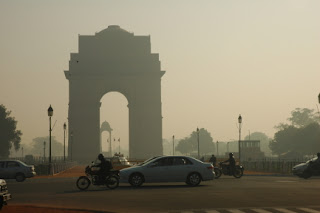Amongst all the flowering trees of peninsular India, the Palas (Flame of the Forest - Butea monosperma) deserves a special mention.  Come spring, and the tree bursts into a stunning display of colour. Driving down from Garudmaachi to Mumbai last week, I saw these trees provide a stark contrast to the dry arid landscape dominated by other trees of mixed deciduous type. Just off the road, this tree caught my attention and I could not just drive past, I just HAD to get down with my camera. Sun going down, nice warm side lighting - any photographer's dream.
Come spring, and the tree bursts into a stunning display of colour. Driving down from Garudmaachi to Mumbai last week, I saw these trees provide a stark contrast to the dry arid landscape dominated by other trees of mixed deciduous type. Just off the road, this tree caught my attention and I could not just drive past, I just HAD to get down with my camera. Sun going down, nice warm side lighting - any photographer's dream.  After what I had thought was a fairly good collection of shots, I planned to hurry on to Mumbai. Barely had I driven a few km. when another Palas halted me in my tracks. Even more resplendent than the first one, it invited me to come and take a closer look. The great poet Kalidas once compared the Palas flowers to a parrot's beak. Going by his simile, this tree would have to be overloaded with parrots !
After what I had thought was a fairly good collection of shots, I planned to hurry on to Mumbai. Barely had I driven a few km. when another Palas halted me in my tracks. Even more resplendent than the first one, it invited me to come and take a closer look. The great poet Kalidas once compared the Palas flowers to a parrot's beak. Going by his simile, this tree would have to be overloaded with parrots !
Kalidas says
-->
-->
-->
-->
plaaSakusauma Ba`aM%yaa SauktuMDo pt%yaila:
saao|ip jambauflama\ Ba`aM%yaa tmailanao Qat-uimacCit
- a group of parrots sitting on the tree were mistaken to be Palas flowers by a some bumblebees. On the other hand, the parrots mistook the bees to be jamun fruits !!
Palas flowers are called Kinshuk in Sanskrit. The name's origin is said to be a question - kim shuka ? Is it a parrot?
Driving down the countryside in the months of Feb-March, it is not difficult to understand why this tree is popularly known as 'Flame of the Forest'। (Some people believe that the Coral tree (Pangara - Erythrina indica) is Flame of the Forest. I have even seen a reference where the Red Silk Cotton (Semul - Bombax ceiba) was given this name. Is there some way to end this argument and give the Palas what is due to it? There can be no other tree that deserves to be called Flame of the Forest. The tree is sacred to Hindus, a fact highlighted by the belief that its set of three leaves represent Brahma, Vishnu and Shiva. They together form the trinity of Gods, who maintain balance in the universe by creating, preserving and destroying. A popular marathi proverb emphatically states - Palasaala paane teen (a palas tree always has three leaves). A rather obvious statement, one would think - but then the proverb simply means just that. "Some things will never change." These trees look rather ungainly in winter, but get completely transformed in months approaching spring. However, the last winter of 2007, I have seen them flowering prematurely, some in December, some even as earlier in late November. Anyone else has seen this? Anyone has an explanation? In a few weeks from now, winter will be on its way out and Vasant rutu will bring rejoice and cheer to the Indian subcontinent. Coral tree, Silk cotton, Amaltas (Indian Laburnum - Cassia fistula) and Tabebuia will all vie with each other for importance. But I will be waiting till the next year, to rejoice yet again sitting under the most glorious of them all - a Flame of the Forest. And yes, the picture would only be complete by listening to the genius of Kumar Gandharva. His Tesul ban phoole is an apt musical tribute to this wonder of nature. Yes, I agree - palasaala paane teen. Some things will never change. I am sure Kalidas would have nodded in agreement.
However, the last winter of 2007, I have seen them flowering prematurely, some in December, some even as earlier in late November. Anyone else has seen this? Anyone has an explanation? In a few weeks from now, winter will be on its way out and Vasant rutu will bring rejoice and cheer to the Indian subcontinent. Coral tree, Silk cotton, Amaltas (Indian Laburnum - Cassia fistula) and Tabebuia will all vie with each other for importance. But I will be waiting till the next year, to rejoice yet again sitting under the most glorious of them all - a Flame of the Forest. And yes, the picture would only be complete by listening to the genius of Kumar Gandharva. His Tesul ban phoole is an apt musical tribute to this wonder of nature. Yes, I agree - palasaala paane teen. Some things will never change. I am sure Kalidas would have nodded in agreement.
P.S. I must thank Prof. Leela Arjunwadkar (and my mother too!) for helping me with the Sanskrit references.











